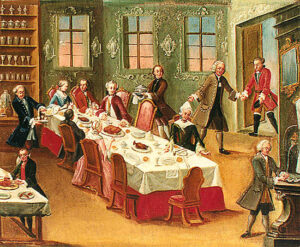
Over the past two weeks, we’ve dressed a lady and a gentleman in 18th century clothing, so it seems only fair that we give these fashionable people a destination. In this case, they are attending a formal dinner.
Table manners were different in the 18th century. As you may have observed from Jane Austin dramas, the lady of the house sat at the head of the table, and the family head at the foot. Guests generally sorted out their own seating based on social rank.
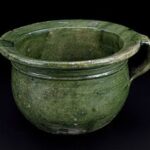
Once seated, guests were expected to remain so and could not leave the room. For convenience, one or more chamber pots were discreetly placed. This allowed conversation to continue as the guest discreetly went about his or her business.
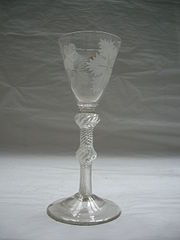
The only other reason for a guest to rise from his or her seat was to raise the wine glass in a toast. Each time a guest wanted a sip of wine, he or she had to challenge another diner by looking him or her in the eye and waiting until the other person raised his or her glass. Each took a swallow and put the glass back on the table until he or she was challenged by someone else. I should imagine this led to many challenges throughout the meal until the dessert course when the rules were relaxed and guests could imbibe at will.
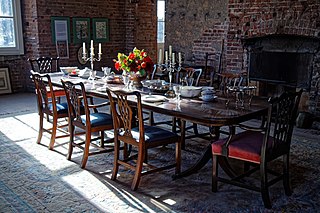
When guests entered the dining room, the table was covered in a white cloth with an undercloth that reached to the floor. There were no napkins, because the English considered individual napkins a French invention and would not use them. [The English and French were at war in the mid-eighteenth century.] Instead, diners wiped their mouths and hands on the table cloth itself. This custom continued into the 19th century.
There were place settings upon the table and perhaps a centerpiece such as a silver candelabra.
The table illustration on the right lacks a table cloth. Perhaps the hostess plans to proceed directly to dessert? Plates were not on the table when diners took their seats but were kept near a fire to keep them warm. When the meal was served, servants brought in the warmed plates and served the food. The kitchen was some distance from the dining room which meant food arrived lukewarm at best, so the plates served a warming function. Plates and serving dishes such as soup tureens were China porcelain, generally with a blue pattern.
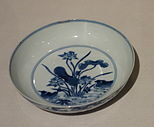
China Porcelain 
Delft Soup Tureen 
Dutch Knife & Fork
Tableware consisted of a fork, knife, and spoon. The two-pronged fork came into use in the 17th century to hold meat in the place so it could be cut. During the 18th century, a third prong was added. With the introduction of forks, knives lost their pointed end in favor of a curved one, and the blade became broader. The diner placed whatever she wished on the knife’s broad blade which she used to bring the food to her mouth. About this time, toothpicks came into use to replace the knife’s point.
The meal often took three or more hours with several courses. Servants laid out each course by bringing out the plates and setting the food on the table so the diners could serve themselves from the dishes nearest to their place. So there might be twenty-five items on the table, but an individual might only be able to sample three or four. The first course was generally a soup or a simple stew.

When a dining course was over, servants cleared the entire table and reset it with new dishes and tableware. This may explain why a set of china often has so many place settings. Even a small party would require a large number of dishes.
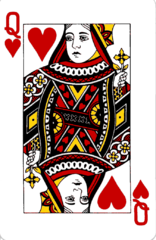
Eventually, it was time for the dessert course. This time, the table cloth was also removed and dessert dishes came out. These included those dishes that look like baskets. After eating so much rich food, diners preferred light desserts such as seasonal fruit and light wafers or small cakes. After dessert, diners enjoyed wine and conversation for about an hour. Then the ladies withdrew for tea and conversation while men remained to smoke, drink port, and converse on topics not meant for ladies’ ears. At a certain point, the men rejoined the ladies for conversation, card games, and dancing.
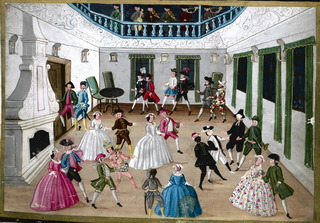
Illustrations
18th century festive meal. From the school of Ziata Koruna.
Chamber Pot. File from Wellcome Images.
Wine glass with rounded funnel, engraved with leaves, butterflies, & cut bunches of grapes. Photo by York Museum Trust Staff.
18th Century Dinning Table at Copped Hall by Acagashi.
Gallery: Chinese Dish from Huntington Museum of Art; 18th Century Delft Soup Tureen; Dutch Knife and Fork.
Fruit Compote Dish from White House Lincoln China.
18th Century Playing Card featuring Elizabeth of York as Queen of Hearts.
Illustration from Sereschen student album, c. 1750.

Sandra Wagner-Wright holds the doctoral degree in history and taught women’s and global history at the University of Hawai`i. Sandra travels for her research, most recently to Salem, Massachusetts, the setting of her new Salem Stories series. She also enjoys traveling for new experiences. Recent trips include Antarctica and a river cruise on the Rhine from Amsterdam to Basel.
Sandra particularly likes writing about strong women who make a difference. She lives in Hilo, Hawai`i with her family and writes a blog relating to history, travel, and the idiosyncrasies of life.


Informative and enjoyable Thanks